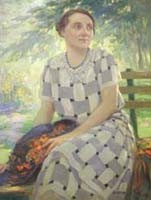
What Does the Endowment Do for Me?
Quick! Name a female poet named George. OK, so there was more than one. Now name a female poet named George who left the bulk of her quarter-million-dollar estate to the University of Cincinnati! Give up? It was
George Elliston,
in whose honor the Elliston Poetry Fund is named.
Each year, established and budding poets are invited to the University of Cincinnati to carry on free readings and workshops for students, staff, faculty and general public. The presentations usually occur in the Elliston Room at the main University Library.
Morrow Fund
Lester Morrow came to UC in 1912 with some work experience and was given credit toward a degree. He earned a degree and did well, leaving UC a large bequest. The money has been used as part of the Deans Discretionary Fund to support projects or salaries of staff identified by the dean. One such item was the Golden Gate Bridge brochure from the 1990s.
According to the UC engineering history book:
More help for faculty development came quite unexpectedly in 1974, in the form of a $1,700,000 giftat that time the largest bequest ever received by the college. The benefactor was Lester C. Morrow, a mechanical engineering graduate of the Class of 1912. He was founder, editor and publisher of Factory magazine and a distinguished alumnus honored at the cornerstone ceremony. Morrow had donated five hundred dollars to the Sesquicentennial Fund for unrestricted uses, and shortly after the celebration he announced his desire to write a bequest to the college in his will. At the deans suggestion, Morrow designated the money to support the individual professional development of faculty members, over and above the general funds of the university. The fund could also be used for seed money to start approved experimental or publication projects, for classroom development, and for continuing education for faculty.
This was in the days before most of the faculty had PhDs. Morrow came to the college with several years of experience. In the minutes of early faculty meetings, there was a petition where he asked that some of his work experienced be counted as his co-op time. They granted the petition. Just shows that it can be helpful to be generous.
I know that the Morrow fund has been a godsend, says Catherine Rafter, associate to the dean of engineering, I know of at least one publication, and it has supported staff members who have worked on behalf of the college.
Rindsberg Fund
The Rindsberg Fellowships program was established to provide fellowships to engineering students who desire to become educators. The award is a fellowship in the amount of $8,000 per year, which will supplement the graduate research stipend that the student is currently receiving. A student receiving a Rindsberg Fellowship will thus receive at least $26,000 per year (minimum $18,000 graduate assistantship plus an $8,000 fellowship). In addition, Rindsberg Fellows receive up to $2,000 per year for such things as travel expenses to conferences and symposia.
The purpose of this program is to prepare engineering PhD candidates for academic careers. All Rindsberg Scholars participate in the Preparing Future Faculty program operated by the College of Engineerings Division of Graduate Studies. This program entails taking two courses on effective teaching, working with a faculty mentor to develop teaching skills and teaching all or part of a regular academic course under the supervision of the faculty mentor. At the completion of the award, Fellows write a synopsis of their experiences and make a presentation to the academic community.
Oesper Fund
The annual Oesper Symposium was established thanks to a bequest from Ralph and Helen Oesper. Ralph E. Oesper was born on June 14, 1886, in Cincinnati. He earned his B.A., M.A. and Ph.D. from U.C.s Chemistry Department. Oesper returned to the University of Cincinnati as a member of the chemistry faculty in 1918, where he remained until his retirement in 1951. He remained active as professor emeritus almost to the day of his death, 26 years later, at the age of 91. Oesper was a prolific writer, publishing more than 300 papers in the fields of analytical, organic, and colloid chemistry and especially in the history of chemistry. He also used his mastery of the German language to translate nearly two dozen books in these fields, as well as countless articles.

Rudolf A. Marcus, 1992 Nobel recipient, was the 1997 Oesper Award Winner.
Oespers many interests and activities, as well as his dedication to the University of Cincinnati, are reflected in his bequest to the Department of Chemistry. Because of the Oesper Banquet and Symposium, UC has hosted many Nobel Prize winners. Besides the annual Oesper Symposium, the bequest has also been used to establish a faculty position in chemical education and the history of chemistry, to support a yearly departmental colloquium on the history of chemistry, to establish scholarships for outstanding high-school chemistry students, and to purchase new additions to the Oesper Collection of Books and Prints in History of Chemistry.
Related Stories
Ancient Maya blessed their ballcourts
April 26, 2024
Using environmental DNA analysis, researchers identified a collection of plants used in ceremonial rituals in the ancient Maya city of Yaxnohcah. The plants, known for their religious associations and medicinal properties, were discovered beneath a plaza floor upon which a ballcourt was built, suggesting the building might have been blessed or consecrated during construction.
OTR mural centerpiece of 'big' celebration of UC alumni
April 26, 2024
New downtown artwork salutes 18 alumni award recipients who personify UC’s alumni success.
UC education allowed couple to make mark on Cincinnati
April 24, 2024
As a native of Defiance, Ohio, John Deatrick, CEAS ’79, says arriving in Cincinnati to attend the University of Cincinnati in 1963 felt like landing in New York City.
